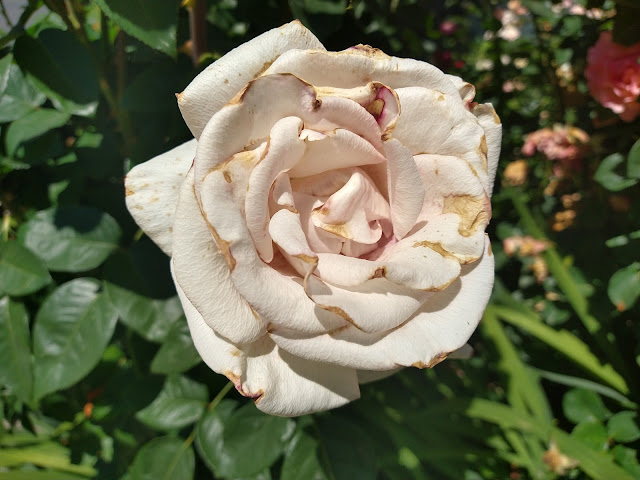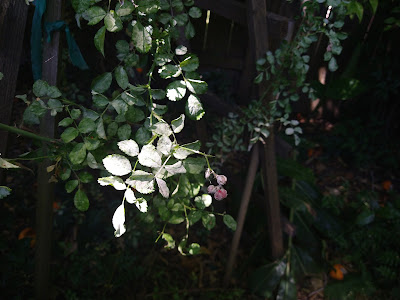

|
| Botrytis freckles and browns the edges of a Pink Promise rose. (Photos: Debbie Arrington) |
May usually is the rosiest month in Sacramento. Warm, dry days coupled with raging growth hormones make for bountiful blooms and healthy plants.
But not this month. Sacramento area rose lovers report problems usually not seen in mid-spring: Botrytis, powdery mildew and blind shoots. All these issues can ruin rose blooms (or eliminate them all together).

|
| Powdery mildew coats foliage on a Dorothy Perkins rambling rose. |
Common in late fall, botrytis attacks buds as they open, turning them to mush. It starts out looking like freckles, then quickly turns petals brown and soft. Roses quite often refuse to fully open.
Powdery mildew is primarily a foliage fungus, covering leaves and stems with what looks like an explosion of powdered sugar. (It can coat buds, too.) Its activated by temperature; days in the 60s or 70s are its sweet spot.
The good news? When days turn 90s degrees, these fungi disappear. They can’t stand high heat. The forecast for this weekend: 92 degrees.
Infected foliage and blooms will fall off and be replaced by healthy growth. Pick up these discards and dispose of them in trash (not compost). That will help cut down on reinfection.

|
| Instead of a bud, there's only a stub on this Marilyn Monroe rose. |
The solution is easy: Cut the blind shoot off. Prune the stem back to just above the first five-leaf leaflet. The bush will soon sprout a new stem, most likely with a bud at the end.
Comments
0 comments have been posted.Sacramento Digs Gardening to your inbox.
Sites We Like
Garden Checklist for week of July 21
Your garden needs you!
* Keep your vegetable garden watered, mulched and weeded. Water before 8 a.m. to reduce the chance of fungal infection and to conserve moisture.
* Feed vegetable plants bone meal, rock phosphate or other fertilizers high in phosphate to stimulate more blooms and fruiting. (But wait until daily high temperatures drop out of the 100s.)
* Don’t let tomatoes wilt or dry out completely. Give tomatoes a deep watering two to three times a week.
* Harvest vegetables promptly to encourage plants to produce more. Squash especially tends to grow rapidly in hot weather. Keep an eye on zucchini.
* Pinch back chrysanthemums for bushy plants and more flowers in September.
* Remove spent flowers from roses, daylilies and other bloomers as they finish flowering.
* Pinch off blooms from basil so the plant will grow more leaves.
* Cut back lavender after flowering to promote a second bloom.
* It's not too late to add a splash of color. Plant petunias, snapdragons, zinnias and marigolds.
* From seed, plant corn, pumpkins, radishes, winter squash and sunflowers.